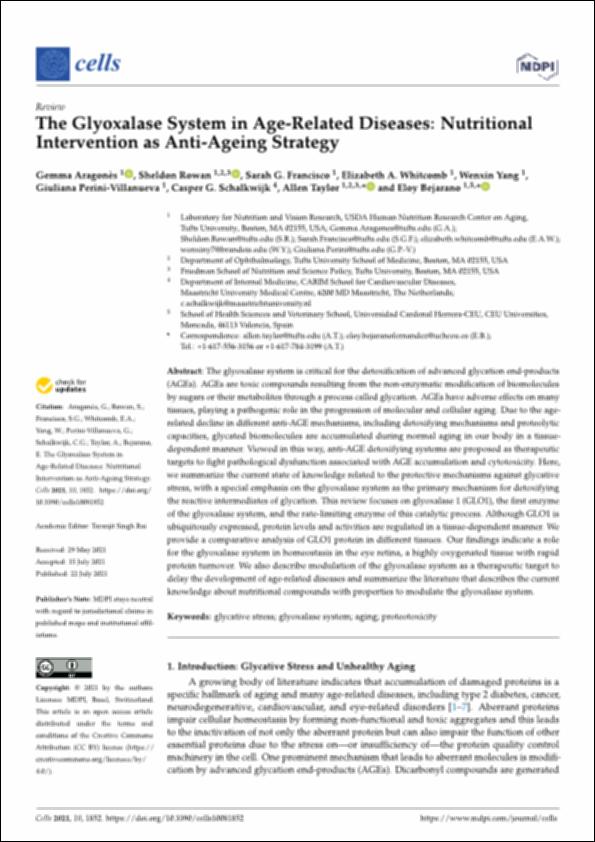Por favor, use este identificador para citar o enlazar este ítem:
http://hdl.handle.net/10637/13616The glyoxalase system in age-related diseases: nutritional intervention as anti-ageing strategy
| Título : | The glyoxalase system in age-related diseases: nutritional intervention as anti-ageing strategy |
| Autor : | Aragonès, Gemma Rowan, Sheldon Francisco, Sarah G. Whitcomb, Elizabeth A. Yang, Wenxin Perini Villanueva, Giuliana Bejarano Fernández, Eloy |
| Materias: | Enzimas - Uso terapéutico.; Oxidation, Physiological.; Enzymes - Therapeutic use.; Cells - Aging.; Oxidación biológica.; Células - Envejecimiento. |
| Editorial : | MDPI |
| Citación : | Aragonès, G., Rowan, S., Francisco, S. G., Whitcomb, E. A., Yang, W., Perini-Villanueva, G., Schalkwijk, C. G., Taylor, A. & Bejarano, E. (2021). The glyoxalase system in age-related diseases: nutritional intervention as anti-ageing strategy. Cells, vol. 10, i. 8 (22 jul.), art. 1852. DOI: https://doi.org/10.3390/cells10081852 |
| Resumen : | The glyoxalase system is critical for the detoxification of advanced glycation end-products (AGEs). AGEs are toxic compounds resulting from the non-enzymatic modification of biomolecules by sugars or their metabolites through a process called glycation. AGEs have adverse effects on many tissues, playing a pathogenic role in the progression of molecular and cellular aging. Due to the agerelated decline in different anti-AGE mechanisms, including detoxifying mechanisms and proteolytic capacities, glycated biomolecules are accumulated during normal aging in our body in a tissuedependent manner. Viewed in this way, anti-AGE detoxifying systems are proposed as therapeutic targets to fight pathological dysfunction associated with AGE accumulation and cytotoxicity. Here, we summarize the current state of knowledge related to the protective mechanisms against glycative stress, with a special emphasis on the glyoxalase system as the primary mechanism for detoxifying the reactive intermediates of glycation. This review focuses on glyoxalase 1 (GLO1), the first enzyme of the glyoxalase system, and the rate-limiting enzyme of this catalytic process. Although GLO1 is ubiquitously expressed, protein levels and activities are regulated in a tissue-dependent manner. We provide a comparative analysis of GLO1 protein in different tissues. Our findings indicate a role for the glyoxalase system in homeostasis in the eye retina, a highly oxygenated tissue with rapid protein turnover. We also describe modulation of the glyoxalase system as a therapeutic target to delay the development of age-related diseases and summarize the literature that describes the current knowledge about nutritional compounds with properties to modulate the glyoxalase system. |
| Descripción : | Este artículo se encuentra disponible en la siguiente URL: https://www.mdpi.com/2073-4409/10/8/1852 En este artículo también participan: Casper G. Schalkwijk y Allen Taylor. Este artículo pertenece al número especial "Mechanisms of Aging and Therapeutic Approaches to Target Age-Associated Chronic Diseases". |
| URI : | http://hdl.handle.net/10637/13616 |
| Derechos: | http://creativecommons.org/licenses/by/4.0/deed.es |
| ISSN : | 2073-4409 (Electrónico) |
| Fecha de publicación : | 22-jul-2021 |
| Centro : | Universidad Cardenal Herrera-CEU |
| Aparece en las colecciones: | Dpto. Ciencias Biomédicas |
Los ítems de DSpace están protegidos por copyright, con todos los derechos reservados, a menos que se indique lo contrario.


